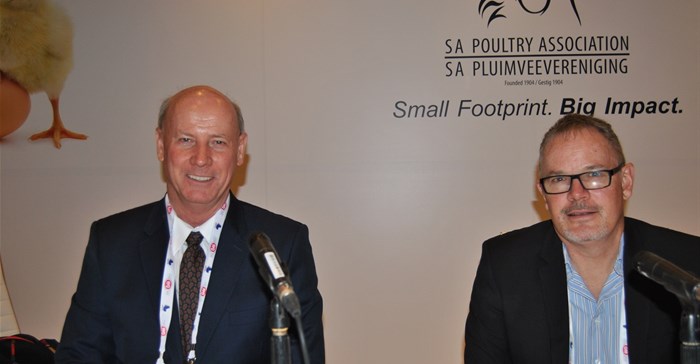Poultry imports are at their highest level in South Africa's history with the flood of cheap chicken imports now accounting for 9.6% of SACU's trade deficit. This is weakening the Rand and negatively impacting the local poultry industry, especially small and emerging farmers.

Kevin Lovell and Marthinus Stander
Speaking at the 110th Avi Africa Conference in Kempton Park, Kevin Lovell, CEO of the South African Poultry Association, said in 2015, poultry imports accounted for a massive R4,6-billion in an industry that is among the most unprotected in the world, with applied average tariff protection equating to barely a few percent a year.
Negative direct and indirect effects if imports
“The fact is that there is no need to import poultry at all. Poultry imports do not have to be part of the trade deficit,” said. “Among other wide-ranging negative direct and indirect effects on the South African economy, imports make the Rand weaker, while offering no benefit to the consumer. The more imports go up, the more South Africa suffers.”
According to Lovell, the volume of bone-in portions that landed in South Africa in March this year was more than that produced by South Africa’s biggest poultry producer. This poses a significant threat not only to local companies and their employees but to other agricultural sectors as well.
“All other adjacent industries are under threat too as we use 90% of soya grown locally and are second only to the consumer as the biggest user of maize,” he says. “More than 130,000 jobs depend on this industry, which progressively go by the wayside as imports grow. It is in the national interest to grow the industry as imports don’t use any of these grains, and take jobs rather than create them, with about 1,000 jobs lost for every 10,000 tons imported.”
“Over the last five years, the local poultry industry has grown by just 1,7% while imports have grown by 140% once population growth is discounted,” he adds. “While South Africans are eating more chicken, most of this growth in consumption comes from imports.”
Tariffs
As a low-margin producer and one of the most unprotected poultry industries in the world, the application by SAPA for the reintroduction of the standard Most Favoured Nation tariff of 37% on poultry from the EU is to make them pay the same that everyone else pays, says Lovell, adding that Canada applies a tariff of 160%, while the EU’s is the equivalent of around 140%.
“The average tariff on imports last year averaged a bit more than 5%, while in 2013, this was as low as 2,5%. This low level of tariff protection is simply because the EU is excluded, and all we ask is that the EU is treated the same way as all other countries. South Africa is currently the EU’s biggest dumping ground for their waste, and imports keep going up as none of our applications have limited trade,” he says.
“The import community is protecting its turf. Importers are not small; collectively they are bigger than our biggest producer. South Africa is one of the top 10 importers of chicken in the world as our sophisticated banking, logistics, distribution and retail sectors make it easy for foreigners to trade with us as it is relatively risk-free.”
Local producers are able to fill the gap
Lovell believes it is imperative that imports be stopped, saying local producers are more than able to fill the gap with efficiency levels and feed-to-food conversion ratios among the top tier in the world.
“It will take around three months to ramp up production by between 10% and 15%, with full replacement of the import volume achieved within the following 12 months,” he says. “This will promote enterprise development and provide stimulus to the growth of emerging farmers as we want imports to be replaced by poultry produced by small, black producers.”
Marthinus Stander, Chairperson of SAPA’s Broiler Organisation, says that an important distinction must be made between imports and dumping, as the imported leg quarters are the by-products of consumption patterns of the US and EU whose consumers prefer the breast meat.
“This hurts local producers the most as South Africans prefer chicken on the bone so that part of the chicken should be what we sell most effectively to our consumers - and at a profit,” says Stander. “Even as these foreign producers export incredible volumes of bone-in imports, they also protect their industries in the US and the EU using phytosanitary measures to restrict our access to those markets, so we cannot sell our breast meat there while they are free to dump here. We say send your whole birds here and let’s compete fairly.”

































